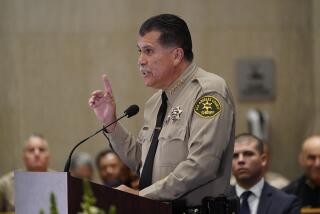Pursuing a chase policy
- Share via
The deaths this week of Charles and Susanne Antuna, whose car was struck by a La Habra patrol car rushing to assist in the pursuit of a fleeing parolee, offer the latest evidence of the extreme danger to innocent bystanders presented by police chases, as well as a reminder that the Los Angeles Police Department has compiled an impressive record of controlling such chases in recent years. Other departments would be wise to emulate its policies, and the LAPD should be cautious about upending its own work in this area.
Under the LAPD’s rules for chasing suspects, officers are given some discretion and allowed to rely on their judgment, but they are directed to do so within thoughtful boundaries. In initiating or continuing a pursuit, officers are expected to consider the potential risk to the public, along with such factors as the speed of the chase compared with surrounding traffic, the weather and the seriousness of the offense for which the suspect is wanted.
Moreover, chases are restricted to a single, primary car with lights and sirens activated, along with a backup or secondary car. Operating under those rules, LAPD officers still end up in traffic accidents -- about 200 cases a year result in the city paying out on legal claims -- but many lives and dollars have been saved.
There is reason to fear that the practices of La Habra police, at least in this case, were not so rigorous. Some witnesses estimated the officer’s speed at 50 mph as she raced through an intersection just after 5 p.m. on Sunday; one told The Times that it appeared to him the officer was driving faster than 65 mph. She wasn’t driving the primary pursuit vehicle, but was racing to assist a fellow officer. Accounts differ as to whether she had activated her lights and siren.
Even as this case has rattled La Habra, the LAPD is in the midst of reviewing its own pursuit policies. A proposal approved by the city’s Police Commission last month would make it easier for officers to go “Code 3,” allowing them to activate their lights and sirens without specific permission. According to proponents of that change, many officers decline to seek permission for Code 3 and instead speed without their lights and sirens, placing the public at greater risk than if officers were allowed to make that decision on their own. The commission unanimously supported the policy change, but City Councilman Bernard C. Parks, a former chief of the LAPD, is pursuing a vote by the council to veto the commission’s action.
Police leaders are often wary of Parks, seeing him as more interested in needling Police Chief William J. Bratton than in crafting responsible police policy. In this case, though, the change merits careful consideration by the council. Strict pursuit rules have served L.A. well. As the Antuna case revealed, police chases are a dangerous business and call for thoughtful policy.
More to Read
Sign up for Essential California
The most important California stories and recommendations in your inbox every morning.
You may occasionally receive promotional content from the Los Angeles Times.









